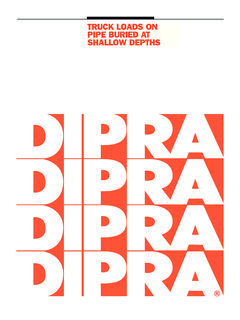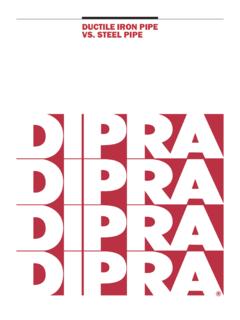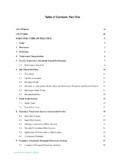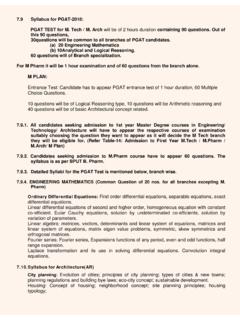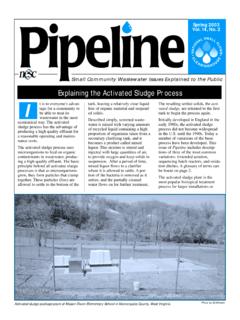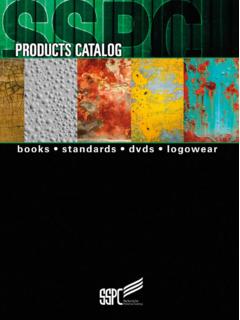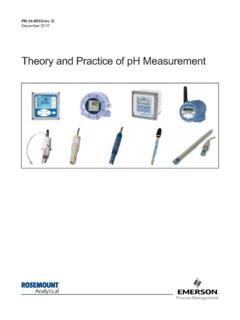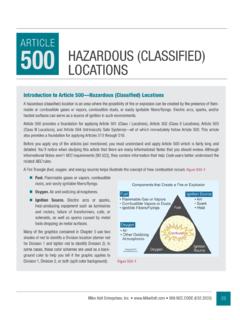Transcription of DUCTILE IRON PIPE FOR WASTEWATER …
1 DUCTILE iron PIPEFOR WASTEWATERAPPLICATIONS DUCTILE iron PIPEFOR WASTEWATER APPLICATIONSThe 1972 AMENDMENTS to Public Law 92-500 (theClean Water Act) established the federal govern-ment s largest domestic funding program in anattempt to improve the quality of the nation s receiv-ing waters through a construction grants program for waste-water treatment works. The act coincided with the formationof the Environmental Protection Agency (EPA) in early1971. Despite dramatic improvements due to the tremendouscommitment of resources and funds under the constructiongrants program, the original intent of the Clean Water Act hasyet to be fully speaking, the responsibility for new projects andcapital improvements, as well as ongoing operation/mainte-nance costs for WASTEWATER systems, now fall directly on localauthorities with minimal assistance from state utilities throughout the nation are taking an effectiveand farsighted approach to all improvement and replacementprojects.
2 They are carefully evaluating present and future sewer systems in terms of design, construction, and mainte-nance criteria, and they are building much more efficientcollection systems, treating sewage under tighter restrictions,and specifying stronger, more durable selecting a pipe material for sewer service, the designengineer must evaluate the pipe s expected performanceand consider the many factors affecting it. These factorsinclude physical strength, available joints and their resis-tance to infiltration/inflow, ease of handling and installation,impact-resistance, resistance to corrosion from hydrogen sul-fide gas and industrial chemicals, life expectancy and main-tenance costs, and system economics such as initial costsand capital costs must be compared to annual operating/maintenance costs and system life to get a true picture of theannual debt service passed on to utility customers. Wastewaterpiping systems greatly influence the annual costs of utilities, afact confirmed by the EPA grants program where billions ofdollars were spent on the following and inflow: conveying and treating massiveflows of unnecessary surface and ground existing piping: Some gravity and forcemains replaced or relined utilizing EPA funding had auseful service life of less than 20 years (in some cases,less than 10 years).
3 Sewers versus pumping: installation of lift stationsin lieu of deep-bury gravity mains where the net result isoften higher total cost (over a 20- or 40-year period),more maintenance, and less iron pipe , which has long been the material stan-dard for sewer force mains, pump station piping, and waste-water treatment plant mechanical piping, has gained greateracceptance for use in gravity mains and Design ConsiderationsDuctile iron pipe is an extremely durable material its perfor-mance should exceed even that of its predecessor, gray CastIron pipe , which has continually served over 570 commu-nities for more than a century. At least 16 communitiescurrently have 150-year-old Cast iron piping still in DUCTILE iron gravity sewer installations laid in accor-dance with good engineering practice should serve for a mini-mum of 50 years with a goal of 100 years without failure orinfiltration/exfiltration in excess of 10 gallons per day per inchdiameter per mile. Zero infiltration is achievable with DuctileIron pipe due to its pressure-tight joints.
4 Realistic allowance,however, should be made for infiltration/inflow at manholes,service laterals, and roof/foundation drain connections, strength of DUCTILE iron pipe permits a wide variety ofdesign applications including shallow bury/heavy traffic loads,deep bury/high soil prism loads, and high iron pipe is designed and manufactured in accor-dance with published standards of the American NationalStandards Institute (ANSI), the American Water WorksAssociation (AWWA), and the American Society of Testingand Materials (ASTM).ANSI/AWWA C150 and ANSI/AWWA C151 the design and manufacturing standards for DUCTILE Ironpipe for water and other liquids under pressure and ASTMA746 is the standard for DUCTILE iron gravity sewer pipe . Thedesign procedure embodied in these standards, which isconsistent for all diameters, is the most conservative for anypiping material commonly used in sewer basis of the design standard is the long-established factthat DUCTILE iron pipe , subjected to internal pressure and exter-nal loading conditions, behaves as a flexible conduit.
5 Thismeans that the pipe is designed separately to withstand exter-nal loads and internal pressure. The result is more conserva-tive than designing for the combined loading , the external loading calculations for DuctileIron pipe utilize a very conservative full earth prism as opposedto a method assuming a narrow trench and arching of thesoil as utilized in polyvinyl chloride (pvc) pipe design recom-mendations. The following criteria are used to calculate therequired thickness of DUCTILE iron pipe in any given load is based on the prism load concept, a conserv-ative assumption for loads experienced by a flexible loads are based upon a single AASHTO H-20 truckwith16,000 pounds wheel load and an impact factor of all load design includes calculation of both ringbending stress and deflection. Ring bending stress is lim-ited to 48,000 psi, providing a safety factor of based onultimate ring of the pipe ring is limited to a maximum of3 percent for cement-lined pipe and 5 percent for flexiblelinings.
6 Again, this limit provides a safety factor of applicable performance limits of the trench types have been defined to provide thedesigner a selection of laying pressure design is based on working pressureplus a surge allowance of 100 psi. A safety factor of isapplied to this 1 provides illustrations of the five standard laying con-ditions, which, along with the design tables, allow engineers tochoose the most economical combination of pipe thicknessand trench conditions for any given application. Tables 2 and 3provide guidelines for depth of bury based on laying condi-tions and assumed earth prism/traffic loadings. Table 2 coverscement-mortar lining, which is the standard lining provided bypipe manufacturers. Table 3 covers flexible linings, which canbe factory-applied for hydrogen sulfide resistance and otherspecial waste stream iron pipe is available in 3- to 64-inch diameters andis manufactured in 18- to 20-foot laying and MaintenanceDurability, ease of installation, available standard fittings, andcontractor familiarity make DUCTILE iron pipe cost-competitiveand the material of choice for current WASTEWATER material strength allows DUCTILE iron pipe to beinstalled with less stringent bedding and backfill specifica-tions.
7 Other flexible piping material, such as pvc, requires veryrigorous bedding/backfill conditions to prevent over-deflec-tion ( egging ) and long-term creep, which can cause exces-sive infiltration or iron gravity and force mains are pressure-tight withdesign working pressures up to 350 psi with a 100 psi surgeallowance. In addition, because of the unique compressiongasket, or push-on joint, used in DUCTILE iron pipe for water-tightness, infiltration/exfiltration and the increased pumping,treatment, and maintenance costs that result are s push-on joint system has been proven effective inactual tests with up to 1,000 psi internal pressure, 430 psi exter-nal pressure, and 14 psi negative air pressure with no leakageor infiltration (see Figure 1). DUCTILE s push-on joints are among the fastest and easiest toassemble joints available today. Also, because DUCTILE iron ismanufactured in 18- to 20-foot lengths, it reduces the numberof joints to be made and speeds installation time in bottle-tight joints also prevent root growthsand intrusion into the pipe and Cast iron tees, wyes, saddles, and other outlets,which provide joint integrity equal to that of the pipe , makeexcellent service connections.
8 In some cases, tees or outletsalso can be used to access the pipe , eliminating the need forexpensive 1 Standard Laying Conditions for DUCTILE iron pipe * For 14-inch and larger pipe ,consideration should be given tothe use of laying conditionsother than Type 1. Flat-bot-tom is defined as undisturbedear th. Loose soil or selectmaterial is defined as nativesoil excavated from thetrench, free of rocks, foreignmaterial, and frozen ear 1*Flat-bottom trench. Loose 2 Flat-bottom trench. Backfill lightly consolidated tocenterline of 3 pipe bedded in 4-inch mini-mum loose soil. Backfill light-ly consolidated to top of 4 pipe bedded in sand, gravel, orcrushed stone to depth of 1/8pipe diameter, 4-inch compacted to top ofpipe. (Approxi mately 80%Standard Proctor, AASHTOT-99.)Type 5 pipe bedded to its centerlinein compacted granular materi-al, 4-in. minimum under granular or select material to top of pipe .(Approximately 90% StandardProctor, AASHTO T-99.)Figure 1 DUCTILE Push-on Joint TestTested:1,000 psi internal pressure430 psi external pressure14 psi negative air pressureResults: No leakage, no 99 69 37 25 ** 15 19 ** 15 19 ** 15 17 19 ** 15 17 20 ** 14 17 19 14 17 19 ** 12 15 17 19 ** 12 15 16 19 ** 12 14 16 19 12 14 16 19 11 13 15 18 11 13 15 18 ** 9 11 13 15 18 ** 9 11 13 15 17 2129 Laying ConditionType 1 Type 2 Type 3 Type 4 Type 5 Maximum Depth of Cover, 2 Maximum Depth of Cover for DUCTILE IronPipe with Cement Lining** Minimum allowable depth of cover is 3 pipes are adequate for depths of cover from ft.
9 Up to the maximum shownincluding an allowance for a single H-20 truck with impact factor unless maximum depth of cover exceeds 100 pipe 14 in. and larger, consideration should be given to the use of laying conditionsother than Type Ring deflection limited to 3%, minimum safety factor of Earth load (Pe) based on soil weight of 120 99 69 37 25 ** 15 19 ** 15 19 ** 15 17 19 ** 15 17 20 ** 14 17 19 14 17 19 ** 12 15 17 19 ** 12 15 16 19 ** 12 14 17 19 12 14 17 19 12 14 17 19 12 14 17 19 ** 9 12 14 17 19 ** 9 12 15 17 19 2845 Laying ConditionType 1 Type 2 Type 3 Type 4 Type 5 Maximum Depth of Cover, 3 Maximum Depth of Cover for DUCTILE IronPipe with Flexible Lining** Examples of flexible linings include polyethylene, polyurethane, epoxy, asphaltic, etc.
10 ** Minimum allowable depth of cover is 3 pipes are adequate for depths of cover from ft. up to the maximum shownincluding an allowance for a single H-20 truck with impact factor unless maximum depth of cover exceeds 100 pipe 14 in. and larger, consideration should be given to the use of laying conditionsother than Type Ring deflection limited to 5%, minimum safety factor of Earth load (Pe) based on soil weight of 120 dependability of DUCTILE iron pipe with push-on joints isevidenced by the fact that, while most state health depart-ments require other piping materials to be encased in concretewhere sewer and water pipes are parallel or cross within a cer-tain distance, DUCTILE iron pipe can generally be used alone,withoutconcrete encasement, in these DUCTILE s strength, it is easy to cut in the field withan abrasive wheel saw, milling wheel saw, or other long service life and durability make DUCTILE iron pipethe favored piping material of operations and maintenancepersonnel.
